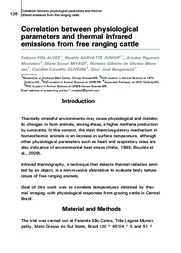Correlation between physiological parameters and thermal infrared emissions from free ranging cattle.
Correlation between physiological parameters and thermal infrared emissions from free ranging cattle.
Author(s): ALVES, F. V.; KARVATTE JUNIOR, N.; MASTELARO, A. P.; MIYAGI, E. S.; MENEZES, G. R. de O.; OLIVEIRA, C. C.; BUNGENSTAB, D. J.
Summary: Thermally stressful environments may cause physiological and metabolic changes in farm animals, among these, a higher methane production by ruminants. In this context, the main thermoregulatory mechanism in homeothermic animals is an increase in surface temperature, although other physiological parameters such as heart and respiratory rates are also indicative of environmental heat stress (Hahn, 1985; Bouzida et al., 2009). Infrared thermography, a technique that detects thermal radiation emitted by an object, is a non-invasive alternative to evaluate body temperature of free ranging animals. Goal of this work was to correlate temperatures obtained by thermal imaging with physiological responses from grazing cattle in Central Brazil.
Publication year: 2016
Types of publication: Paper in annals and proceedings
Unit: Embrapa Beef Cattle
Keywords: Cattle, Ruminante, Ruminants, Temperatura, Thermal radiation, Thermography
Observation
Some of Embrapa's publications are published as ePub files. To read them, use or download one of the following free software options to your computer or mobile device. Android: Google Play Books; IOS: iBooks; Windows and Linux: Calibre.
Access other publications
Access the Agricultural Research Database (BDPA) to consult Embrapa's full library collection and records.
Visit Embrapa Bookstore to purchase books and other publications sold by Embrapa.

